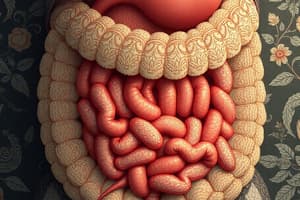Podcast
Questions and Answers
Which organ is specifically responsible for producing bile to aid in digestion?
Which organ is specifically responsible for producing bile to aid in digestion?
- Pancreas
- Salivary glands
- Gallbladder
- Liver (correct)
Aerobic metabolism does not require oxygen.
Aerobic metabolism does not require oxygen.
False (B)
What molecule is primarily responsible for powering cellular work?
What molecule is primarily responsible for powering cellular work?
ATP
The ________ refers to the process of nutrients traveling from the GI tract to the blood or lymph.
The ________ refers to the process of nutrients traveling from the GI tract to the blood or lymph.
Match the following types of exercise with their characteristics:
Match the following types of exercise with their characteristics:
What is the primary function of antibodies in the body?
What is the primary function of antibodies in the body?
Nutrient recommendations can be set based on the consumption of healthy individuals when there's insufficient evidence for an RDA.
Nutrient recommendations can be set based on the consumption of healthy individuals when there's insufficient evidence for an RDA.
Concentrated sweeteners added to food decrease nutrient ________.
Concentrated sweeteners added to food decrease nutrient ________.
Which of the following correctly describes a severe allergic reaction?
Which of the following correctly describes a severe allergic reaction?
Anemia is a condition where the oxygen-carrying capacity of red blood cells is increased.
Anemia is a condition where the oxygen-carrying capacity of red blood cells is increased.
What term is used to describe the amount of a substance absorbed from the intestine into the bloodstream?
What term is used to describe the amount of a substance absorbed from the intestine into the bloodstream?
_____ is an eating disorder where a person doesn't eat enough, leading to dangerous weight loss in older adults.
_____ is an eating disorder where a person doesn't eat enough, leading to dangerous weight loss in older adults.
Match the following terms with their definitions:
Match the following terms with their definitions:
What defines the energy expended by the body at rest?
What defines the energy expended by the body at rest?
Individuals with bulimia nervosa exhibit regular patterns of fasting and purging.
Individuals with bulimia nervosa exhibit regular patterns of fasting and purging.
The _____ principle is used to prevent bias in intervention studies.
The _____ principle is used to prevent bias in intervention studies.
Study Notes
Nutrient Absorption and Metabolism
- Nutrients travel from the GI tract lumen to blood or lymph after digestion, essential for nutrient delivery.
- Energy from carbohydrates, fats, and proteins recommended for a healthy diet varies within a calculated range.
- Accessory organs aiding digestion include salivary glands, liver, gallbladder, and pancreas despite not being part of the intestinal tract.
Key Metabolic Processes
- Krebs Cycle plays a crucial role in aerobic metabolism, requiring oxygen to generate ATP for cellular energy.
- Aerobic metabolism uses oxygen to produce ATP, vital for continuous exercise (e.g., walking, jogging).
Dietary Recommendations
- Adequate nutrition includes sufficient calories, essential nutrients, and fiber for overall health.
- Nutrient recommendations based on healthy individuals' consumption levels are established when sufficient evidence for an RDA is absent.
Exercise and Energy Systems
- Short-duration, high-intensity activities rely on immediate energy sources with little to no oxygen (anaerobic metabolism).
- The resting energy expenditure is the largest component of energy use, sustaining life activities like respiration and circulation.
Health and Nutrition Issues
- Severe allergic reactions involve multiple systems, indicating a strong immune response.
- Anemia is characterized by reduced oxygen-carrying capacity of red blood cells due to low hemoglobin.
- Anorexia nervosa results in dangerous nutrient inadequacy, often leading to organ malfunction.
Body Composition and Assessment
- Body composition can be estimated using air displacement and bioelectrical impedance analysis, both non-invasive methods.
- The proportion of body mass includes water, lean mass, and fat, providing insight into overall health.
Food and Digestion
- Chyme refers to food once chewed and moistened, ready for further digestion.
- Bile, produced by the liver and stored in the gallbladder, acts as an emulsifier to aid fat digestion.
- Microvilli, resembling brush bristles, increase intestinal surface area for nutrient absorption.
Disorders and Interventions
- Binge eating disorder involves overeating episodes without compensatory behaviors like purging.
- Interventions focusing on lifestyle skills support healthy weight management.
- The body weight that maintains a person's health and happiness is referred to as weight set point.
Food Safety and Resistance
- Antibiotic resistance occurs when bacteria evolve to survive antibiotic treatment, complicating infection management.
- Immunoglobulins in blood recognize and eliminate harmful pathogens like bacteria and viruses.
Biochemical Components
- Carotenoids serve as precursors to active vitamin A, essential for various body functions.
- The basic building blocks of organisms are composed of carbon, hydrogen, oxygen, and nitrogen formed in diverse combinations.
Experimental Research and Bias
- Blinding techniques prevent bias in intervention studies by keeping the research team or subjects unaware of treatment allocations.
- Body Mass Index (BMI) is a simple ratio of weight to height, used as a screening tool for estimating health risks.
Studying That Suits You
Use AI to generate personalized quizzes and flashcards to suit your learning preferences.
Description
This quiz covers essential concepts in nutrition and digestion, including how nutrients are absorbed from the gastrointestinal tract into the bloodstream or lymph. It also discusses the recommended energy intake from carbohydrates, fats, and proteins for a balanced diet, as well as the role of accessory digestive organs. Test your knowledge of these vital processes!




